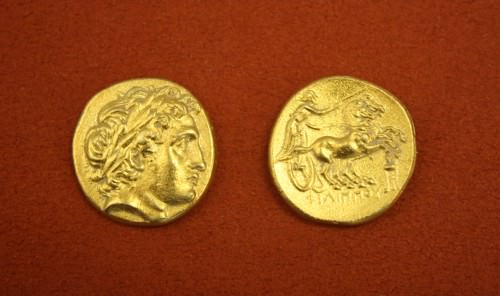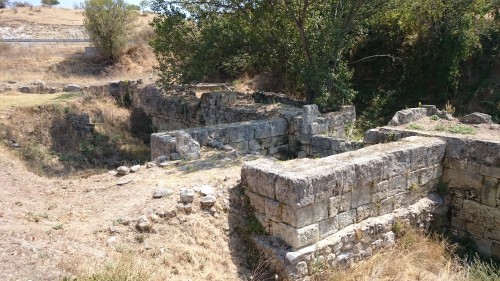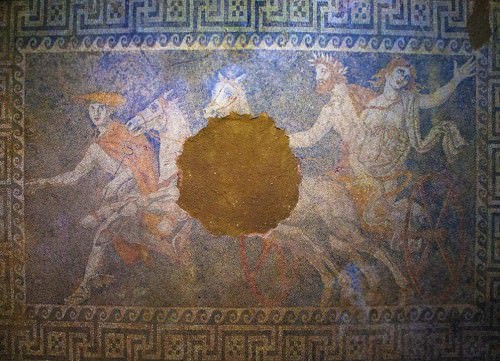Gordian Emperors › Amphipolis » Ancient origins
Articles and Definitions › Contents
- Gordian Emperors › Antique Origins
- Amphipolis › Ancient History
Ancient civilizations › Historical and archaeological sites
Gordian Emperors › Antique Origins
Definition and Origins

When Maximinus Thrax was named Roman emperor upon the death of Alexander Severus, the news was not well-received by many in Rome and the Roman Senate considered him an illiterate barbarian. His financial excesses, principally used to fund his military expeditions in Germany, weighed heavily on the minds of many of the senators. An opportunity soon arose to free themselves of this unpopular emperor when Gordian I was proclaimed emperor by enraged noblemen in Carthage. Unfortunately, it would not be that easy a task to eliminate Maximinus.
GORDIAN I
Marcus Antonius Gordianus Sempronianus, known to history as Gordian I, was born in 159 CE to an unknown father and mother, although there were claims that he was descended from Roman Emperor Trajan on his mother's side and the Republic reformers Gracchi, Tiberius and Gaius, on his father's. Gordianus was a wealthy landowner who served as Roman senator and consul as well as the governor of several provinces including Lower Britain. Although he was eighty-years-old, Emperor Maximinus appointed him governor of Africa; something he would soon regret.
Maximinus's expeditions in Germany had proven to be a considerable drain on the empire ’s finances. He confiscated the estates of many of the wealthy and cut grain subsidies, something that affected everyone, especially the poor. There were repercussions throughout the empire. One of the emperor's many agents was collecting taxes in Gordianus' North African province (present-day Tunisia) when several young provincial nobles mobilized their tenants and killed him. Angry with Maximinus' tax policies, they decided they wanted a new emperor and chose their governor Gordianus, who, although taken by surprise, reluctantly accepted. Historian Herodian in his History of the Roman Empire remarked on this election to the imperial office.
It happened that on the day these events occurred (the killing of the tax collector) Gordian was at home resting, enjoying a brief respite from his labors and duties. Accompanied by the entire band with drawn swords, the youths (those who had killed the tax collector) overpowered the guards on duty at the gates and burst into the house…. Standing around him, they draped him in a purple cloak and greeted him with the imperial honors.
Confused, the newly proclaimed emperor threw himself on the floor, begging for his life. After being reassured of their intentions, he was given a stern warning by one of the youths. “…death awaits you this very day if you decide against us and refuse to join us, and we shall die ourselves, if need be, after we have killed you.”
GORDIAN II
THE GORDIANS PLEDGED THE SUPPRESSION OF ALL INFORMERS, A RETURN OF EXILES, AND BONUSES FOR THE ARMY.
Assuming the additional name of Africanus, on March 22, 238 CE, he left his home in Thysdrus and arrived in Carthage with his son Gordianus, a former governor and consul in his own right, at his side. Upon their entrance into the city, he declared to the citizenry his son to be Augustus as well - the only difference is that the forty-six-year-old Gordian II did not receive the additional title of high priest or pontifex maximus. Without delay, a message was forwarded to the Roman Senate who approved them both as co-emperors. While neither would ever step foot in Rome, the new emperors pledged the suppression of all informers, a return of exiles, and bonuses for the army. After accepting the Gordians as co-emperors, the Senate voted to deify the slain Emperor Alexander Severus and declare Maximinus an enemy of the state; with many of his supporters in Rome being murdered.
Next, word was sent out to all of the provincial governors to pledge their allegiance to the new emperors. Capellianus, governor of Numidia and an ally of Maximinus, was angered by the Senate declaring his friend an enemy of the state and mobilized his legions to march on Carthage. Although the governor resented the Senate's decree, he also had a personal vendetta against Gordian I. Herodian explained the nature of the feud, “Gordian was hostile to Capellianus because they had earlier been involved in a lawsuit. When he assumed the title of emperor, Gordian sent a man to replace Capellianus and ordered the governor to leave the province.” The governor's troops were too much for the small militia defending Carthage. In the skirmish Gordian II was killed. When he received word of his son's death, the elder Gordian became distraught and hanged himself. The date was May 12, 238 CE. They had served only twenty-two days.
According to Herodian's account, Capellianus “put to death all the prominent men who survived the battle, plundered the temples, and seized the public and private funds.” The death of the emperor - their one hope against the cruel Maximinus - caused many of the people of Rome and Carthage to live in fear. Herodian wrote,
When the death of the elder Gordian was reported at Rome, the people and the senate particularly were completely bewildered, dumfounded to learn that Gordian, in whom they had placed their hope, was dead. They knew that Maximinus, who was naturally hostile and antagonistic toward them, would spare no one. Now that he had good reason for hatred, he would as a matter of course vent his rage upon them as upon acknowledged enemies.
 GORDIAN III
GORDIAN III

GORDIAN III
When notified of the emperors' deaths, the Roman Senate deified them both and quickly appointed new co-emperors - DeciusCaelius Calvinus Balbinus and Marcus Clodius Pupienus Maximus. As with the Gordians, a Council of Twenty was named to give them assistance. However, regardless of the Senate's approval, neither man was well-received by the Roman populace who wanted the throne to remain in the Gordian family, namely the thirteen-year-old nephew of Gordian II, Marcus Antonius Gordianus. To appease the public and prevent riots, the young Gordianus was named Caesar. Just as the people had feared, after hearing the news of Gordian I and II's appointment as co-emperors (he did not receive word of their deaths), Maximinus marched on Italy. He arrived at the city of Aquileia where he met with considerable resistance. Tired and hungry, the Praetorian Guard turned on him and his son and killed them as they slept.
After defeating Maximinus Thrax's forces at Aquileia, the victorious Emperor Pupienus returned to Rome a hero. Yet, the jubilation would be short-lived for he and Balbinus were seized by the Praetorian Guard and murdered; their bodies were dragged through the Roman streets. The young Gordian III was proclaimed emperor. Herodian added, “Leaving the corpses exposed in the street, the praetorians took up Gordian Caesar and proclaimed him emperor, since at the moment they could find no other candidate for the office.”
Gordian III, born in 225 CE, was only thirteen when he ascended to the imperial throne; however, because of his age, he was given little if any real authority and most of the power remained in the hands of the Roman Senate. Luckily for both Gordian and the empire, a man who had risen through the military ranks and several imperial offices came to exert considerable influence on the young emperor, especially after he was named commander of the Praetorian Guard. His name was Gaius Furius Sabina Aquila Timesitheus He would gain even more sway when Gordian married his young daughter Furia Sabinia Tranquilliana in 241 CE.

Bimetallic Medallion of Emperor Gordian III
Unfortunately for the youthful emperor, his short reign would see considerable unrest. He did have one small victory, however, the soldiers that had killed his uncle and grandfather were all drummed out of the army - sadly this would leave North Africa poorly protected. Due to the reduced number of legions in Africa, in 240 CE Marcus Asinius Sabinianus, the new governor of Africa, declared himself to be emperor; however, his self-proclaimed ascension did not last long, the governor of neighboring Mauretania quickly suppressed it. Next, and more importantly, problems brewed in the east: the new Persian king Shapur Ibegan calling himself the King of Kings of Iran and Non-Iran. He boldly invaded the Roman province of Syria and threatened the capital city of Antioch. Regrettably, because of a continuing battle with the Goths along the Danube, the Roman army was unable to answer the attack. After suppressing the rebellion, Timesitheus mobilized his troops and with the assistance of the Roman fleet moved eastward, saving Antioch. Not only were the Persians defeated at Rhesaina in Mesopotamia but the Romans were also able to recapture the fallen cities of Carrhae and Nisibis.
Before any further action could be taken against the Persians, Timesitheus became ill and died. His successor, Philip the Arab, a commander in the Guard and suspect in the death of Timesitheus, named himself the young emperor's regent. When Gordian III chose to march on the Persian capital of Ctesiphon, Philip resisted; he had realized the imperial throne was within his grasp. According to the Historia Augusta, Philip engineered a plot against the emperor, “Philip spread talk among the soldiers to the effect that Gordian was young and could not manage the Empire, and that it were better for someone to rule who could command the army and understood public affairs.”
When Philip refused to follow his orders, the angry Gordian gave the troops a choice: him or Philip. Because of their lack of confidence in the nineteen-year-old emperor, they chose Philip. On February 25, 244 CE, Gordian III was killed near the city of Zaitha on the Euphrates River; his body was returned to Rome and the Senate was told the emperor died of natural causes.The memory of Gordian III is recorded in the Historia Augusta :
He was a light-hearted lad, handsome, winning, agreeable to everyone, merry in his life, eminent in letters; in nothing, indeed, save in his age was he unqualified for empire. Before Philip's conspiracy he was loved by the people, the senate, and the soldiers as no prince had ever been before.
Supposedly, after he had killed the emperor, Philip, “… called him divine, even among the soldiers with whom he had made his conspiracy, and worshipped him with a mixture of a serious spirit and the shrewdness of an alien.” Philip the Arab quickly negotiated a peace with the Persians and returned to Rome where he was officially acclaimed as the empire's new emperor
Amphipolis › Ancient History
Definition and Origins

Amphipolis, located on a plain in northern Macedonia near Mt. Pangaion and the river Strymon, was an Athenian colony founded c. 437 BCE on the older Thracian site of Ennea Hodoi. Thucydides relates that the Athenian general Hagnon so named the town because the Strymon surrounds the site on three sides ("amphi" means "on both sides") and also relates that he built a fortification wall on its unprotected side. The city and its sea port, Eion, prospered due to its favourable geographic location and the proximity of abundant natural resources, especially gold, silver, and timber. In 2012 CE an impressive Hellenistic tomb was discovered, one of the most important archaeological finds of the last 40 years which has, once more, put Amphipolis in the lime-light.
HISTORICAL OVERVIEW
The Spartan general Brasidas conquered the city in 424 BCE and defeated Kleon when Athens attempted to re-take Amphipolis two years later. In the latter battle Brasidas had brilliantly employed his peltasts to defeat the larger Athenian hoplite army, but the Spartan leader himself eventually succumbed to his wounds. The great military commander was buried in the city's agora and honoured with annual games. Amphipolis came back under Athenian control following the Peace of Nikias in 421 BCE; however, the Amphipolitans, in the event, opted to remain an independent polis ( city-state ) and in 367 CE made an alliance with the Chalkidian League. In 364 BCE the Athenians, still as eager as ever to guarantee their grain supply from the Black Sea, once more tried to make themselves masters of strategically important Amphipolis, this time led by the general Timotheos and with the initial encouragement of the Macedonian king Perdikkas III, who ruled Amphipolis at that time. Unwilling in the end to hand over the city, Perdikkas established a garrison there and, on his death, Macedonian control fell to his successor, Philip II.
PROBABLY A MACEDONIAN ADMINISTRATIVE CAPITAL, THE CITY WAS ALSO THE SITE OF THE MOST IMPORTANT MACEDONIAN MINT.
Although now a Macedonian city, Amphipolis did retain some degree of independence and many of her political institutions such as a demos or popular assembly, remained intact. Over time, as more and more Macedonian colonists settled in the polis, Philip, and later his son Alexander the Great, used Amphipolis as a base from which to attack Thrace and Asia. Probably a Macedonian administrative capital, the city was also the site of the most important Macedonian mint where, amongst others, the famous gold staters were produced. The site has also been a source of documentation regarding Macedonian military regulations. We are informed that soldiers who displayed great courage on the battlefield should be given a double share of the booty, that a general should ensure his army does not devastate a defeated territory by burning corn or destroying vines, and that soldiers must have their equipment in order, not sleep on guard duty, and report such failures amongst their comrades to their superior. Transgressors could be fined and those who reported them received a bonus.

Macedonian Gold Stater
When Rome conquered Macedon in 168 BCE, Amphipolis retained some importance as one of the four regional capitals. The city was an important stopping point on the via Egnatia highway which connected Greece to Asia. The city acquired impressive fortifications, especially around the ancient acropolis, measuring over 7,000 metres long and over 7 metres high in places. Augustus conferred the status of civitas libera, making it a free city and the emperor was even given the title of Ktistes or founder. In later times, from c. 500 CE, Amphipolis became the seat of an episcopal see and no fewer than four basilicas attest to the religious importance of the site in Late Antiquity. The site was abandoned in the 8th and 9th centuries CE following the Slavic invasions after which citizens of Amphipolis relocated to nearby Eion which survived into the Byzantine period. Amphipolis was again settled in the 13th to 14th centuries CE, from which period the remains of two towers survive.
ARCHAEOLOGICAL REMAINS
Excavations of Roman Amphipolis have revealed traces of all the impressive architecture one would expect from a thriving Roman city. A bridge, gymnasium, public and private monuments, sanctuaries, and cemeteries all attest to the city's prosperity. From the early Christian period (after 500 CE) there are traces of four basilicas, a large rectangular building which may have been a bishop's residence, and a church.

Fortifications of Amphipolis
Basilica A was a three-aisled basilica with two floors and two rows of ten columns down its length. It was constructed on the site of a Roman bath. Parts of the marble flooring, some polychrome mosaics of wildlife, pieces of a hexagonal platform, and two rows of seats of the synthronon survive. Basilica B originally measured 16.45 x 41.6 metres and it too had marble decoration and mosaics. Basilica C dates to the second half of the 5th century CE and had two interior colonnades of six columns, of which the bases survive, as do mosaics of various geometric and wildlife designs. Basilica D is contemporary with Basilica C and had a marble and brick flooring; 15 column bases and various mosaics also survive.
The large rectangular structure which may have served as an episcopal palace measured over 48 metres wide and had walls 1.3 metres thick. Three cisterns in the southwest corner constructed using waterproof cement survive. Another building of interest is the early Christian church which included a large hexagonal chamber surrounded by a circular wall. The 6th century CE church had two floors with colonnades and much of the interior was tiled with marble, including the mosaic -tile flooring.Finally, two Byzantine towers either side of the Strymon River survive. The best preserved is the north tower which was built in 1367 CE and which stands 10 metres tall and originally had three stories. Both towers offered some protection to the nearby monastery on Mt. Athos.

Persephone Mosaic, Amphipolis
THE AMPHIPOLIS TOMB
The 4th century BCE burial mound at Amphipolis was discovered in 2012 CE and it is one of the most important archaeological finds of the last 40 years. It has a surrounding wall measuring almost 500 metres in circumference and constitutes the largest burial site ever found in Greece. The scale and impressive architecture of the tomb, which uses marble imported from Thassos, suggest the occupant was a person of great importance. An almost intact skeleton has been discovered within a wooden coffin placed in a limestone tomb in the third chamber of the complex. The chief archaeologist at the site, Katerina Peristeri, stated that the tomb dated to after the death of Alexander the Great (323 BCE) and, "in all probability belongs to a male and a general". Artefacts from the complex include a large stone lion (discovered in 1912 CE but now thought to have once stood atop the mound), two caryatids, two sphinxes, and a large pebble mosaic measuring 4.5 by 3 metres which depicts the god Hades abducting Persephone in a chariot led by Hermes. Historians and enthusiasts alike eagerly await the findings of the on-going research on the Amphipolis tomb and to discover just who was buried in such a splendid tomb.
LICENSE:
Article based on information obtained from these sources:with permission from the Website Ancient History Encyclopedia
Content is available under License Creative Commons: Attribution-NonCommercial-ShareAlike 3.0 Unported. CC-BY-NC-SA License